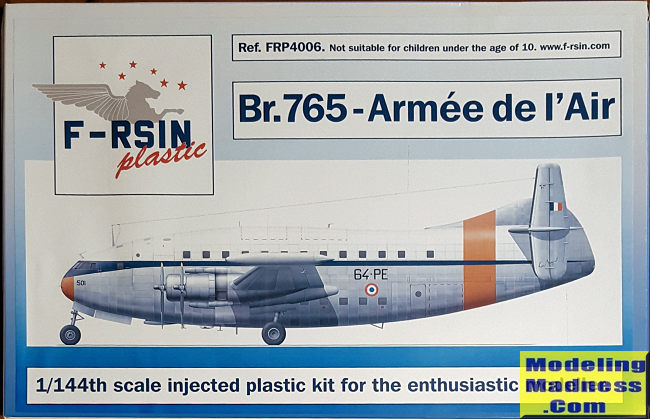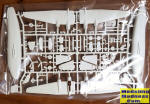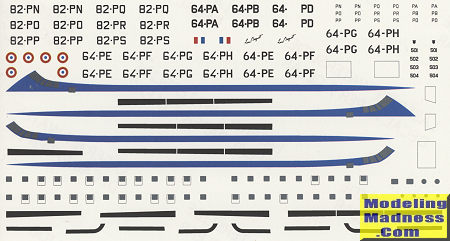
| KIT #: | FRP 4006 |
| PRICE: | ~$30.00 |
| DECALS: | Multiple options |
| REVIEWER: | Scott Van Aken |
| NOTES: | Short run kit |

| HISTORY |
Bréguet began design work on the Bréguet 761 double-deck airliner even before the end of the Second World War, in 1944. It was decided that a medium-range airliner with seating for over 100 passengers would be built. The design envisaged using readily available engines with the aim of ease of manufacture and an early first-flight date. The design was known as Project 76-1. The aircraft was destined not to be the first French postwar design to fly, an honour which instead fell to the Sud-Est Languedoc, a civilianised Bloch MB161. The prototype Br.761, F-WASK, first flew at Villacoublay on 15 February 1949.
The 761 featured a cantilever wing set at mid-height on the bulky fuselage. The retractable tricycle landing gear featured dual-wheel main units. The empennage had twin fins and rudders on a vestigial central fin. The prototype was powered by four 1,580 hp (1,180 kW) SNECMA 14R-24 radial engines. The Bréguets serving with Air France had up to 107 seats and an elevator between the two floors.
The prototype was followed by three Br.761S pre-production aircraft powered by 2,020 hp (1506 kW) Pratt & Whitney R-2800-B31 radial engines. These were fitted with 12 ft 1½in (3.70 m) diameter Hamilton Standard propellers. The aircraft successfully completed their trials incident-free. Their first flights were in 1951 and 1952.
The French Government ordered 12 production aircraft, the Bréguet 76-3, which was later redesignated Br.763. Six aircraft were to be operated by Air France and the other six by the Ministry of Transport. The 763 had more powerful engines, a 1.20 metres (3 ft 11 in) larger wingspan, strengthened wings and a three-crew flight deck (earlier aircraft had four crew). The 763 first flew on 20 July 1951 and entered service with Air France during autumn 1952.
The Air France aircraft had accommodation for 59 passengers on the top deck, and 48 on the lower deck, although the aircraft was capable of carrying 135 passengers in a high-density layout. During 1964 Air France transferred six Br.763s to the French Air Force. The air force also acquired the three pre-production Br.761S aircraft and four new Br.765 Sahara freighter aircraft with removable cargo doors.
In October 1955 an order for 30 Bréguet Br.765 Sahara aircraft for the Armée de l'Air was announced. This order was cancelled by the end of the year, but construction on four aircraft was so far advanced that they were completed. These entered service with 64 Escadre de Transport.
The French Air Force acquired the three pre-production Br.761S aircraft, these and the six Sahara aircraft acquired from Air France provided the French Air Force with a valuable transport fleet for moving personnel and materials to the Pacific nuclear testing areas. The Sahara fleet was retired in 1972.
| THE KIT |
 F-RSIN
kits are all typical French short run injected offerings. The plastic has some
rather prominent mold seams on all the parts and some are sufficient to become
flash. Sprue attachment points are large and many of them fall over into the
part itself, requiring careful removal. Typical of some resin kits, I found some
voids or short shot areas in the plastic, mostly on the trailing edges of the
control surfaces that will need to be repaired with plastic card.
F-RSIN
kits are all typical French short run injected offerings. The plastic has some
rather prominent mold seams on all the parts and some are sufficient to become
flash. Sprue attachment points are large and many of them fall over into the
part itself, requiring careful removal. Typical of some resin kits, I found some
voids or short shot areas in the plastic, mostly on the trailing edges of the
control surfaces that will need to be repaired with plastic card.
There are parts in the kit to make either a 761S, 763, or 765. This included wing tip tanks, different central tail tips and different noses. There are also numerous differences in antenna suits. The instructions indicate which are which.
 Instructions
are quite basic with only an exploded view as the lone assembly guide. A full
color painting and marking guide provides just profiles so applying the wing
marking will take a bit of sleuthing. All aircraft are unpainted metal with
white fuselage upper surfaces and most have some areas of da-glo orange on the
nose and rear fuselage. I highly recommend doing a web search for photos on this
one as it will help. The decal sheet is laser jet printed so doesn't include
white. A smaller sheet (not shown) provides the white backings needed. The sheet
has a single carrier and will need to have each marking cut out. From the look
of it, any military aircraft can be modeled. The sheet also includes the
de-icing boots though you may want to paint those on.
Instructions
are quite basic with only an exploded view as the lone assembly guide. A full
color painting and marking guide provides just profiles so applying the wing
marking will take a bit of sleuthing. All aircraft are unpainted metal with
white fuselage upper surfaces and most have some areas of da-glo orange on the
nose and rear fuselage. I highly recommend doing a web search for photos on this
one as it will help. The decal sheet is laser jet printed so doesn't include
white. A smaller sheet (not shown) provides the white backings needed. The sheet
has a single carrier and will need to have each marking cut out. From the look
of it, any military aircraft can be modeled. The sheet also includes the
de-icing boots though you may want to paint those on.
| CONCLUSIONS |
This kit really is for experienced modelers and will task your skills to properly build it. But when you are done you will have a rather unique model to add to your collection.
| REFERENCES |
https://en.wikipedia.org/wiki/Br%C3%A9guet_763_Deux-Ponts
December 2019
Copyright Modeling Madness.com. All rights reserved If you would like your product reviewed fairly and
fairly quickly, please
contact
the editor or see other details in the
Note to
Contributors. Back to the Main Page
Back to the Review
Index Page
Back to the Previews Index Page